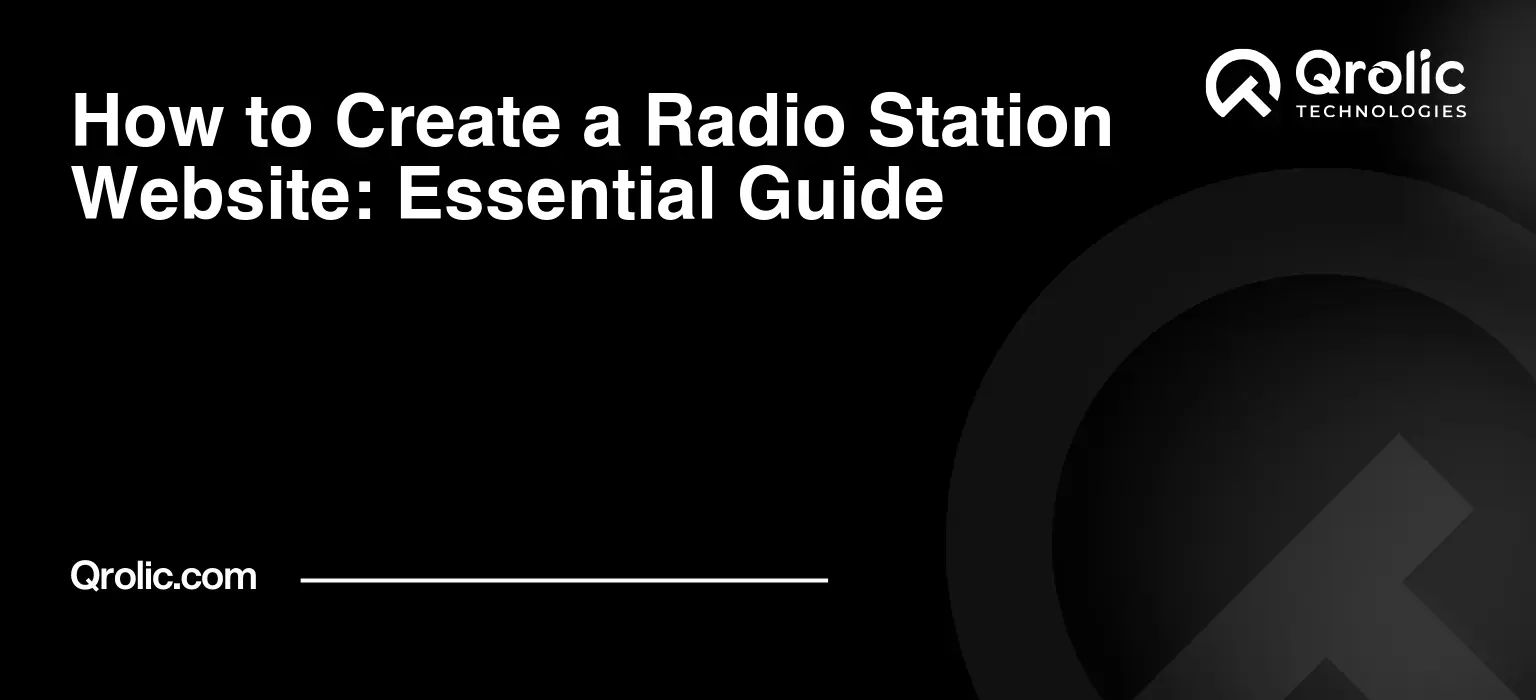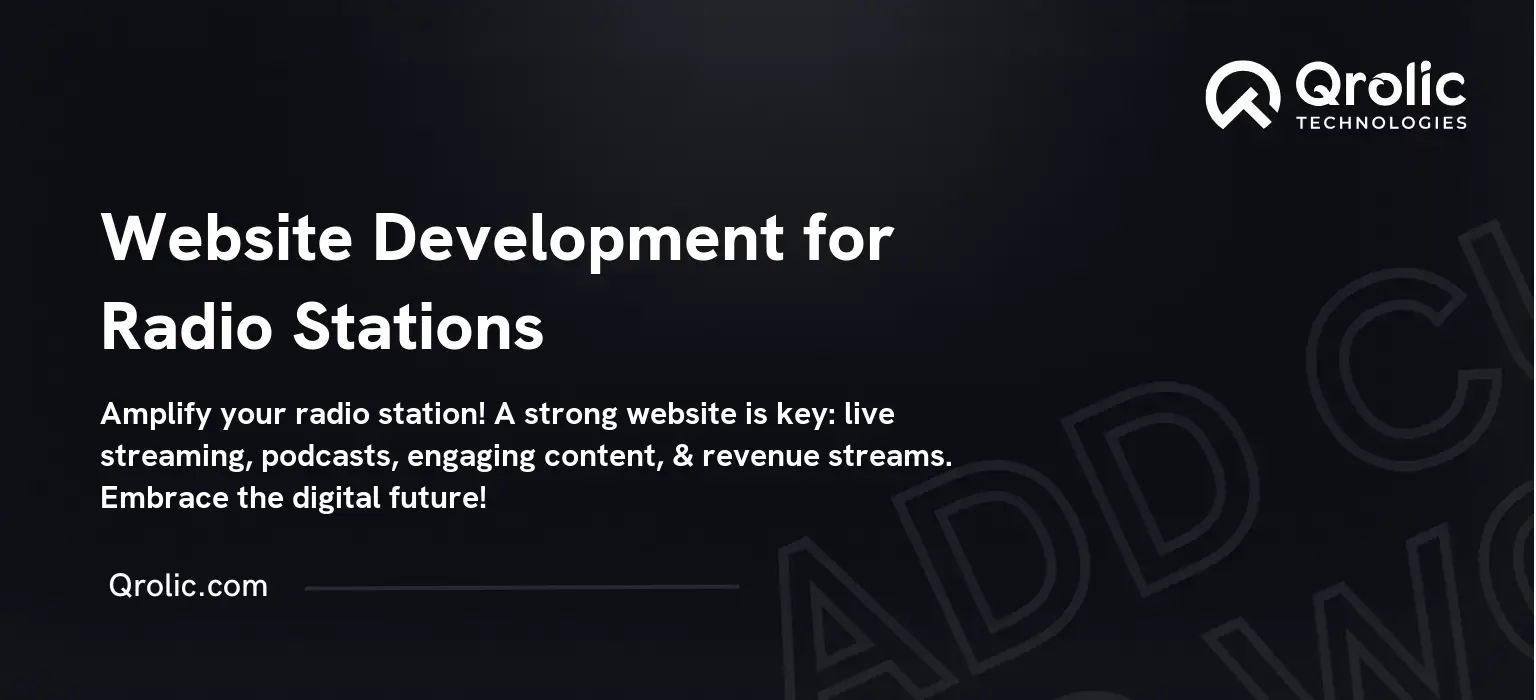Quick Summary:
- A website is essential for your radio station’s global reach.
- Plan your site well for mobile-friendliness and fast streaming.
- Create engaging content and optimize for search engines (SEO).
- Promote, analyze, and monetize your website for continuous success.
Table of Contents
- Why Your Radio Station NEEDS a Website (More Than Ever)
- Beyond the Airwaves: Expanding Your Reach
- Understanding the Modern Listener: What They Expect
- The Cost of NOT Having a Website
- Planning Your Radio Station Website: The Foundation for Success
- Defining Your Target Audience: Who Are You Trying to Reach?
- Setting Clear Goals: What Do You Want to Achieve?
- Choosing the Right Platform: CMS, Streaming Solutions, and More
- Broadcasting Design: Visual Identity and User Experience
- Building Your Radio Station Website: A Step-by-Step Guide
- Step 1: Choosing a Domain Name and Hosting Provider
- Step 2: Installing and Configuring Your CMS (WordPress Example)
- Step 3: Designing Your Website: Choosing a Theme and Customizing It
- Step 4: Creating Essential Pages: Home, About, Schedule, Contact
- Step 5: Integrating Your Live Stream: Making it Easy to Listen
- Step 6: Adding Content: Engaging Your Listeners Online
- Step 7: Optimizing for Search Engines (SEO)
- Step 8: Promoting Your Website: Getting the Word Out
- Step 9: Analytics and Monitoring: Tracking Your Progress
- Step 10: Regularly Update and Maintain Your Website
- Monetizing Your Radio Station Website: Generating Revenue Online
- Online Advertising: Display Ads, Banner Ads, and More
- Sponsorships: Partnering with Local Businesses
- Merchandise Sales: Selling Branded Products
- Premium Content: Offering Exclusive Content for Subscribers
- Affiliate Marketing: Earning Commissions on Sales
- Qrolic Technologies: Your Partner in Website Development and Design
- Our Services:
- Why Choose Qrolic Technologies?
- Common Mistakes to Avoid: Setting Yourself Up for Success
- The Future of Radio Station Websites: Trends and Predictions
- Conclusion: Your Radio Station’s Digital Future Starts Now
Why Your Radio Station NEEDS a Website (More Than Ever)
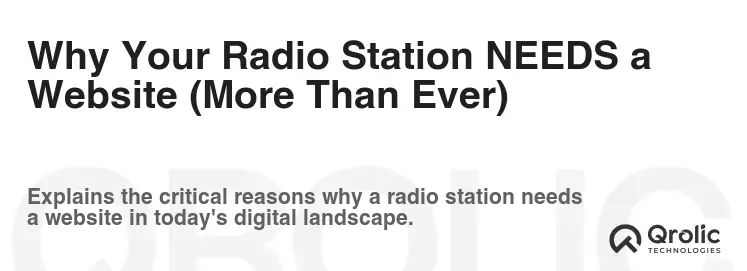
In a world saturated with streaming services and on-demand content, you might wonder: is a website really necessary for a radio station? The answer is a resounding YES! Think of your website as your digital command center, a hub for all things related to your station, and the foundation for expanding your reach beyond the airwaves. A powerful radio station website is no longer a “nice-to-have”; it’s an essential guide to survival and thriving in today’s competitive media landscape.
Beyond the Airwaves: Expanding Your Reach
-
Global Accessibility: Your signal might only reach a specific geographic area, but your website can be accessed by anyone, anywhere in the world. Think expats craving a taste of home, or new listeners discovering your unique sound.
-
On-Demand Content: Missed your favorite show? No problem! A website allows you to host podcasts, archived shows, and exclusive content, giving listeners the power to tune in on their own schedule.
-
Community Building: Create forums, comment sections, and social media integrations to foster a sense of community and engagement among your listeners.
-
Revenue Generation: Websites offer a multitude of monetization opportunities, from online advertising and sponsorships to merchandise sales and premium content subscriptions.
Understanding the Modern Listener: What They Expect
Today’s listeners are digitally savvy. They expect instant access to information, seamless streaming experiences, and personalized content. Your website needs to cater to these expectations to remain relevant and engaging.
-
Mobile-Friendliness: The vast majority of web traffic comes from mobile devices. Ensure your website is fully responsive and optimized for smartphones and tablets.
-
Fast Loading Speeds: Nobody wants to wait for a website to load. Optimize your images, minimize code, and choose a reliable hosting provider to ensure lightning-fast performance.
-
Intuitive Navigation: Make it easy for visitors to find what they’re looking for. Use clear and concise navigation menus, search functionality, and well-organized content.
-
High-Quality Streaming: Your online stream should be just as reliable and enjoyable as your terrestrial broadcast. Invest in a robust streaming solution and ensure your website seamlessly integrates with it.
The Cost of NOT Having a Website
Think of your website as an investment, not an expense. The cost of not having a website can be far greater than the cost of building and maintaining one.
-
Lost Listeners: Potential listeners may never find you if they can’t easily search for your station online.
-
Missed Revenue Opportunities: You’re leaving money on the table if you’re not monetizing your online presence.
-
Damaged Brand Reputation: An outdated or non-existent website can make your station look unprofessional and irrelevant.
Planning Your Radio Station Website: The Foundation for Success
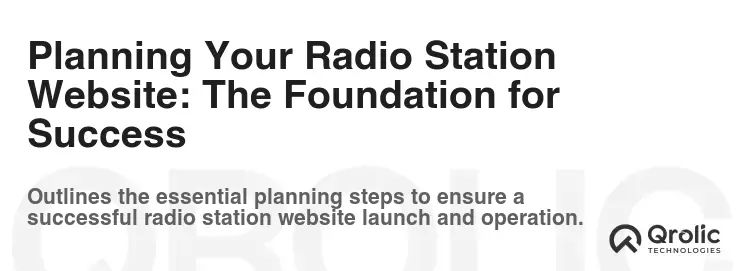
Before diving into the technical aspects of building a website, it’s crucial to develop a solid plan. This involves defining your target audience, setting clear goals, and choosing the right platform and broadcasting design.
Defining Your Target Audience: Who Are You Trying to Reach?
Understanding your target audience is the first step in creating a website that resonates with them. Consider factors such as:
-
Age: Are you targeting teenagers, young adults, or an older demographic?
-
Location: Is your audience primarily local, regional, or global?
-
Interests: What are their hobbies, passions, and lifestyle choices?
-
Listening Habits: When do they listen to the radio, and what kind of content do they prefer?
By understanding your target audience, you can tailor your website’s design, content, and functionality to their specific needs and preferences.
Setting Clear Goals: What Do You Want to Achieve?
What do you hope to accomplish with your radio station website? Be specific and measurable. Some common goals include:
-
Increase Listenership: Attract new listeners and retain existing ones.
-
Boost Brand Awareness: Establish your station as a leader in the community.
-
Generate Revenue: Monetize your online presence through advertising, sponsorships, or premium content.
-
Enhance Listener Engagement: Foster a sense of community and interaction.
-
Promote Events: Announce and promote upcoming events and concerts.
-
Recruit Volunteers/Staff: Attract talent to support your station.
Clearly defined goals will help you make informed decisions throughout the website development process.
Choosing the Right Platform: CMS, Streaming Solutions, and More
Selecting the right platform is crucial for building a website that meets your needs and fits your budget. Here’s a breakdown of the most popular options:
Content Management System (CMS): A CMS allows you to easily create, manage, and update your website’s content without needing to know how to code.
- WordPress: The most popular CMS in the world, WordPress is highly flexible, customizable, and SEO-friendly. It offers a vast library of themes and plugins to extend its functionality.
- Joomla: Another popular CMS, Joomla is known for its robust features and security.
- Drupal: A powerful CMS favored by developers, Drupal is highly customizable and scalable.
Streaming Solutions: You’ll need a reliable streaming solution to broadcast your radio station online.
- Shoutcast: A popular and affordable streaming solution that’s been around for years.
- Icecast: An open-source streaming server that’s free to use.
- Live365: A comprehensive streaming platform that includes licensing and royalty management.
- TuneIn: TuneIn is a platform for listening to online radio, a great option to consider.
Website Builders: Website builders offer a drag-and-drop interface that makes it easy to create a website without any coding knowledge.
- Squarespace: A user-friendly website builder with a focus on aesthetics and design.
- Wix: Another popular website builder with a wide range of templates and features.
- Headless CMS: This platform only handles the backend of the site content which allows greater flexiblity for developers to use the frontend framework of their choice.
The best platform for your radio station will depend on your technical skills, budget, and specific needs. WordPress is often the best choice for most stations due to its flexibility, ease of use, and SEO-friendliness.
Broadcasting Design: Visual Identity and User Experience
Your website’s design should reflect your station’s brand and appeal to your target audience. Consider the following elements:
-
Logo: Your logo should be prominently displayed on your website and across all your marketing materials.
-
Color Scheme: Choose a color scheme that is consistent with your brand and visually appealing.
-
Typography: Select fonts that are easy to read and complement your brand’s personality.
-
Imagery: Use high-quality images and videos that are relevant to your content.
-
User Experience (UX): Ensure your website is easy to navigate and provides a seamless user experience.
A well-designed website will not only attract visitors but also keep them engaged and coming back for more.
Building Your Radio Station Website: A Step-by-Step Guide
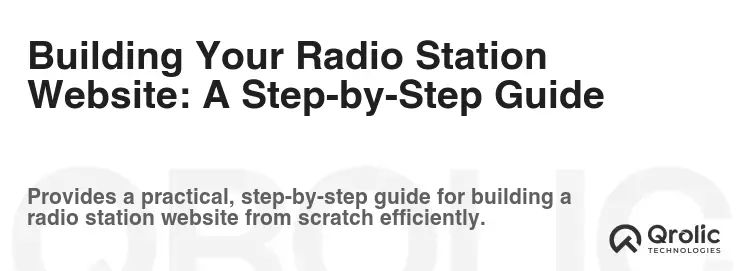
Now that you have a plan in place, it’s time to start building your website. This section will provide a step-by-step guide to creating a professional and engaging online presence for your radio station.
Step 1: Choosing a Domain Name and Hosting Provider
Your domain name is your website’s address on the internet. Choose a domain name that is:
-
Easy to Remember: Avoid using complicated words or phrases.
-
Relevant to Your Station: Include your station’s name or a keyword that describes your content.
-
Available: Check if the domain name is available before registering it.
Once you’ve chosen a domain name, you’ll need to find a hosting provider to store your website’s files and make them accessible to visitors. Look for a hosting provider that offers:
-
Reliable Uptime: Choose a provider with a high uptime guarantee (99.9% or higher).
-
Fast Servers: Ensure the provider has fast servers to ensure quick loading speeds.
-
Good Customer Support: Select a provider with responsive and helpful customer support.
-
Scalability: Choose a provider that allows you to easily scale your resources as your website grows.
Popular hosting providers include Bluehost, SiteGround, HostGator, and AWS.
Step 2: Installing and Configuring Your CMS (WordPress Example)
If you’ve chosen WordPress as your CMS, you’ll need to install and configure it on your hosting account. Most hosting providers offer a one-click WordPress installation.
Once WordPress is installed, you’ll need to configure it with the following settings:
-
Website Title and Tagline: Choose a descriptive title and tagline for your website.
-
Permalinks: Set your permalinks to “Post name” for better SEO.
-
Theme: Choose a theme that is visually appealing and functional. There are thousands of free and premium WordPress themes available.
-
Plugins: Install essential plugins such as Yoast SEO, Contact Form 7, and a caching plugin.
Step 3: Designing Your Website: Choosing a Theme and Customizing It
Your website’s theme determines its overall look and feel. Choose a theme that is:
-
Responsive: Ensures your website looks good on all devices.
-
Customizable: Allows you to easily change the colors, fonts, and layout.
-
SEO-Friendly: Optimized for search engines.
-
Compatible with Your Plugins: Works well with the plugins you plan to use.
Once you’ve chosen a theme, you can customize it to match your brand’s identity. This includes:
-
Uploading Your Logo: Add your logo to the header of your website.
-
Changing the Colors and Fonts: Customize the colors and fonts to match your brand.
-
Adding Content to Your Homepage: Create a compelling homepage that showcases your station’s best content.
Step 4: Creating Essential Pages: Home, About, Schedule, Contact
Every radio station website should include the following essential pages:
-
Homepage: Your homepage should provide an overview of your station and its content.
-
About Us: This page should tell your station’s story and introduce your team.
-
Schedule: Display your programming schedule in an easy-to-read format.
-
Contact Us: Provide contact information for listeners, advertisers, and media inquiries.
Other important pages include:
-
Blog: Share news, interviews, and behind-the-scenes content.
-
Podcast Archive: Host archived episodes of your radio shows.
-
Events Calendar: Promote upcoming events and concerts.
Step 5: Integrating Your Live Stream: Making it Easy to Listen
Make it easy for visitors to listen to your live stream directly from your website. This can be achieved by:
-
Embedding a Player: Embed a streaming player directly on your homepage or on a dedicated “Listen Live” page.
-
Using a Streaming Plugin: Many WordPress Plugins allow you to easily integrate your live stream.
-
Providing Direct Links: Offer direct links to your stream in various formats (e.g., MP3, AAC).
Ensure your streaming player is compatible with all major browsers and devices.
Step 6: Adding Content: Engaging Your Listeners Online
Content is king! Keep your website fresh and engaging by regularly adding new content, such as:
- Blog Posts: Share news, interviews, and behind-the-scenes content.
- Behind-the-Mic Insights: Offer exclusive content like interviews with show hosts, deep dives into show preparation, and listener Q&A sessions to build a stronger connection.
- Community Spotlights: Highlight local events, organizations, and interesting individuals to cement your station’s role as a community hub.
- Music News and Reviews: Stay current with the latest music releases, industry trends, and provide insightful album and single reviews tailored to your station’s genre.
- Podcasts: Host archived episodes of your radio shows.
- Content Segmentation: Break down longer radio shows into distinct podcast episodes for easy listening and categorization.
- Exclusive Podcast Content: Offer podcasts with content that’s not aired on the radio, enticing listeners to engage more with your online platform.
- Videos: Create videos of interviews, performances, and behind-the-scenes footage.
- Images: Use high-quality images to enhance your content.
- Interactive Content: Create quizzes, polls, and contests to engage your audience.
- Schedules and Playlists: Make this information easily accessible to listeners.
- Playlist Integration: Sync your station’s playlist automatically to your website, allowing listeners to see what’s playing and discover new music they love.
- DJ Insights: Provide commentary or curated playlists from DJs, giving listeners personal recommendations and insights.
Step 7: Optimizing for Search Engines (SEO)
Radio station website, the goal is to be easily found by those searching for broadcasting design and stations online. Search Engine Optimization (SEO) is crucial for driving traffic to your website. This involves:
- Keyword Research: Identify the keywords that your target audience is using to search for radio stations like yours.
- Local SEO: Incorporate location-based keywords into your website content to attract local listeners. For example, “radio station [city name]” or “[city name] music.”
- Genre Specific Keywords: Include keywords relevant to your station’s genre, such as “classic rock radio,” “country music station,” or “hip-hop radio online.”
- On-Page Optimization: Optimize your website’s content, title tags, and meta descriptions with relevant keywords.
- Title Tags: Craft compelling title tags for each page that include your primary keywords. Keep them under 60 characters.
- Meta Descriptions: Write concise and engaging meta descriptions that encourage users to click on your website in search results. Keep them under 160 characters.
- Header Tags (H1-H6): Use header tags to structure your content and highlight important keywords.
- Off-Page Optimization: Build backlinks from other reputable websites to increase your website’s authority.
- Local Directories: List your station in local business directories, such as Yelp, Google My Business, and local Chamber of Commerce websites.
- Guest Blogging: Write guest posts for other websites in your niche and include a link back to your radio station’s website.
- Partnerships: Partner with other local businesses or organizations and exchange links on each other’s websites.
- Mobile Optimization: Ensure your website is mobile-friendly, as Google prioritizes mobile-first indexing.
- Site Speed Optimization: Improve your website’s loading speed, as it is a ranking factor. Optimize images, leverage browser caching, and use a Content Delivery Network (CDN).
- Internal Linking: Link relevant pages within your own website to improve navigation and SEO.
Step 8: Promoting Your Website: Getting the Word Out
Once your website is live, it’s time to promote it to your target audience. This can be done through:
- On-Air Promotion: Mention your website on the air during your radio shows.
- Social Media: Share your website’s content on social media platforms such as Facebook, Twitter, and Instagram.
- Email Marketing: Build an email list and send out newsletters promoting your website’s content.
- Online Advertising: Run online ads on Google and social media to reach a wider audience.
- Partnerships: Collaborate with other businesses and organizations to promote your website.
Step 9: Analytics and Monitoring: Tracking Your Progress
Use analytics tools such as Google Analytics to track your website’s performance. This will help you:
- Monitor Traffic: See how many visitors are coming to your website.
- Track Engagement: See how long visitors are spending on your website and what pages they are viewing.
- Identify Trends: Identify trends in your website’s traffic and engagement.
- Measure ROI: Measure the return on investment of your marketing efforts.
By tracking your website’s performance, you can make informed decisions about how to improve it and achieve your goals.
Step 10: Regularly Update and Maintain Your Website
Your website is not a “set it and forget it” project. It’s important to regularly update and maintain it to ensure it remains secure, functional, and engaging. This includes:
- Updating Your CMS and Plugins: Keep your CMS and plugins up to date to protect against security vulnerabilities.
- Backing Up Your Website: Regularly back up your website to protect against data loss.
- Monitoring Your Website for Errors: Regularly monitor your website for errors and fix them promptly.
- Adding New Content: Keep your website fresh and engaging by regularly adding new content.
Monetizing Your Radio Station Website: Generating Revenue Online
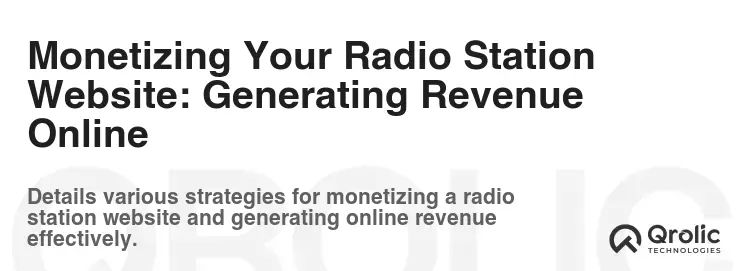
A website can be a valuable source of revenue for your radio station. Here are some ways to monetize your online presence:
Online Advertising: Display Ads, Banner Ads, and More
Display ads are a common way to monetize a website. You can sell ad space on your website to local businesses or use an ad network such as Google AdSense.
- Programmatic Advertising: Use programmatic advertising platforms to automate the process of selling and displaying ads on your website.
- Native Advertising: Create ads that blend seamlessly with your website’s content.
- Targeted Advertising: Target ads to specific demographics or interests to increase their effectiveness.
Sponsorships: Partnering with Local Businesses
Partner with local businesses to sponsor your website’s content or sections. This can be a great way to generate revenue and build relationships with local businesses.
- Content Sponsorship: Partner with businesses to sponsor specific blog posts, podcasts, or videos.
- Event Sponsorship: Partner with businesses to sponsor online or offline events.
- Homepage Sponsorship: Offer a business the opportunity to sponsor your website’s homepage.
Merchandise Sales: Selling Branded Products
Sell branded merchandise such as t-shirts, hats, and mugs on your website. This can be a great way to generate revenue and promote your station’s brand.
- E-commerce Integration: Integrate an e-commerce platform such as Shopify or WooCommerce into your website to easily sell merchandise online.
- Print-on-Demand: Use a print-on-demand service to avoid having to hold inventory.
- Promotional Products: Offer promotional products such as pens, keychains, and stickers.
Premium Content: Offering Exclusive Content for Subscribers
Offer premium content such as exclusive podcasts, videos, and articles for paying subscribers. This can be a great way to generate recurring revenue and reward your loyal listeners.
- Membership Platform: Use a membership platform such as Patreon or MemberPress to manage your subscriptions.
- Exclusive Content Library: Create a library of exclusive content that is only available to subscribers.
- Early Access: Give subscribers early access to new content.
Affiliate Marketing: Earning Commissions on Sales
Partner with other businesses and promote their products or services on your website. You’ll earn a commission on any sales that are generated through your affiliate links.
- Amazon Associates: Join the Amazon Associates program and promote products on your website.
- Commission Junction: Join Commission Junction and partner with a variety of businesses.
- Impact Radius: Join Impact Radius and partner with a variety of businesses.
Qrolic Technologies: Your Partner in Website Development and Design

At Qrolic Technologies (https://qrolic.com/), we understand the unique needs of radio stations in the digital age. We offer a range of website development and broadcasting design services to help you create a powerful online presence that engages your listeners, expands your reach, and generates revenue.
Our Services:
- Custom Website Design: We create custom website designs that are tailored to your station’s brand and target audience.
- CMS Development: We specialize in developing websites using popular CMS platforms such as WordPress, ensuring ease of use and scalability.
- Streaming Integration: We seamlessly integrate your live stream into your website, making it easy for listeners to tune in.
- SEO Optimization: We optimize your website for search engines to ensure it ranks well in search results.
- E-commerce Integration: We integrate e-commerce platforms into your website, allowing you to sell merchandise and premium content online.
- Website Maintenance and Support: We provide ongoing website maintenance and support to ensure your website remains secure, functional, and up-to-date.
Why Choose Qrolic Technologies?
- Experience: We have extensive experience in developing websites for radio stations.
- Expertise: Our team of skilled designers and developers is dedicated to providing high-quality services.
- Customer Service: We provide excellent customer service and are committed to your satisfaction.
- Affordable Pricing: We offer competitive pricing for our services.
Contact Qrolic Technologies today to learn more about how we can help you create a successful radio station website!
Common Mistakes to Avoid: Setting Yourself Up for Success
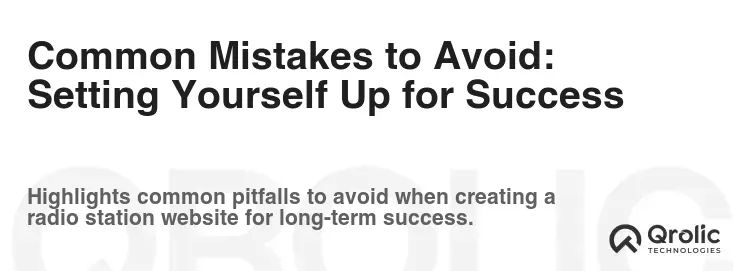
Building a successful radio station website requires careful planning and execution. Avoid these common mistakes:
- Ignoring Mobile Optimization: Make sure your website is responsive and looks good on all devices.
- Slow Loading Speeds: Optimize your images and code to ensure fast loading speeds.
- Poor Navigation: Make it easy for visitors to find what they’re looking for.
- Lack of Content: Keep your website fresh and engaging by regularly adding new content.
- Ignoring SEO: Optimize your website for search engines to drive traffic.
- Neglecting Security: Keep your CMS and plugins up to date to protect against security vulnerabilities.
- Failing to Promote Your Website: Promote your website on the air, on social media, and through other marketing channels.
- Ignoring Analytics: Use analytics tools to track your website’s performance and make informed decisions.
The Future of Radio Station Websites: Trends and Predictions

The future of radio station websites is bright. Here are some trends and predictions:
- Personalization: Websites will become increasingly personalized to the individual listener.
- Interactive Content: Websites will feature more interactive content such as quizzes, polls, and contests.
- Virtual Reality (VR): VR technology will be used to create immersive listening experiences.
- Artificial Intelligence (AI): AI will be used to personalize content and improve the user experience.
- Integration with Smart Speakers: Websites will be seamlessly integrated with smart speakers such as Amazon Echo and Google Home.
By embracing these trends, radio stations can create websites that are more engaging, informative, and profitable.
Conclusion: Your Radio Station’s Digital Future Starts Now
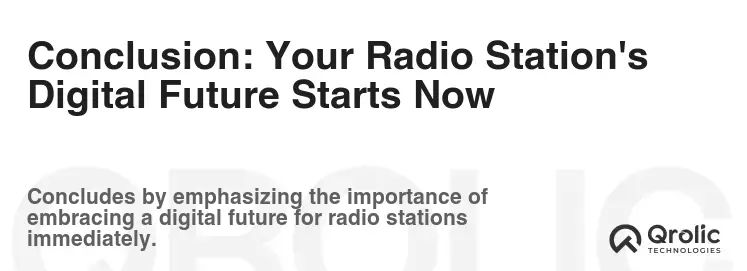
Creating a radio station website is no longer optional; it’s essential for survival and success in today’s competitive media landscape. By following the steps outlined in this essential guide, you can create a website that engages your listeners, expands your reach, and generates revenue. Remember to plan carefully, choose the right platform, optimize for search engines, and promote your website effectively. And don’t hesitate to seek help from professionals like Qrolic Technologies to ensure your website is a success. Your radio station’s digital future starts now!
